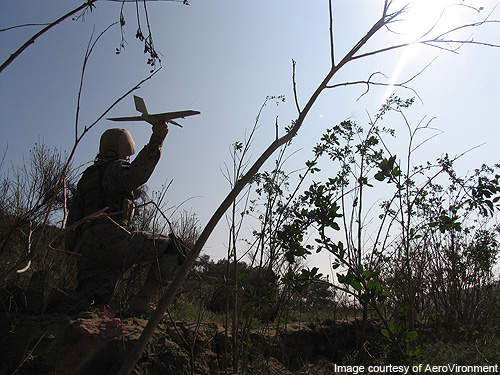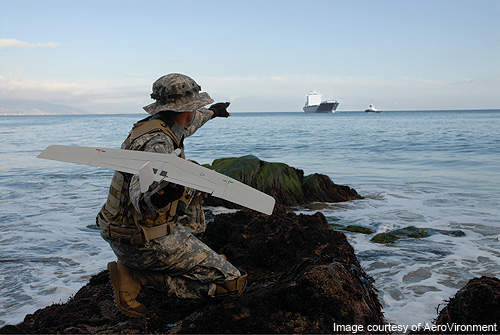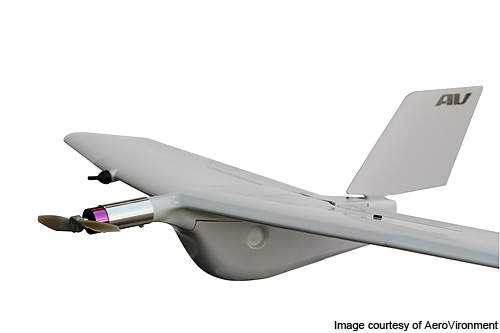The Avinc Wasp is a lightweight, robust, low altitude remote controlled unmanned aerial system (UAS) designed and manufactured jointly by AeroVironment (AV) and the Defence Advanced Research Projects Agency (DARPA). The UAS encompasses a man-portable Wasp unmanned aerial vehicle (UAV), a ground control unit (GCU) and communication ground station (CGS). Developed for the US Armed Forces, the Wasp executes intelligence, surveillance, and reconnaissance (ISR) operations.
The UAV captures real-time imagery or videos and transmits them to the ground control unit (GCU) through a line of sight datalink, thereby, facilitating faster and safer movement through urban and mountainous regions. It is a hand-launched and waterproof vehicle, which lands automatically on either land or water.
Flying at a maximum altitude of 10,00ft, the UAV can provide high resolution colour or infrared imagery and videos to the GCU and remote viewing units. It is the smallest UAV ever built by AV and implements technology similar to that of the Raven RQ11-B and the Puma.
Wasp UAV design
The Wasp UAS has been designed to execute both military and commercial operations in day or night conditions.
It is an advanced small unmanned aerial system used to perform base security, route reconnaissance, planning, battle damage assessment and force protection missions.
Two prototypes of the vehicle have been built and examined by the US Armed Forces for military operations in urban terrain missions.
The two folding wings of the UAV are designed in a rectangular shape with slightly swept leading edges. The UAV is fitted with an electric motor driven two-bladed propeller in the front section. It is also equipped with an internal GPS or Inertial Navigation System, autopilot and two on-board cameras located in the lower fuselage section and front side of the aircraft.
Wasp micro air vehicle (MAV) development
AeroVironment began to build the Wasp in 1998 under a contract with DARPA. The Wasp recorded 1hr 47mins of endurance in August 2002, making it a micro class UAV.
In December 2006, the Wasp was chosen as the micro air vehicle (MAV) for the BATMAV (Battlefield Air Targeting Micro Air Vehicle) programme by the US Air Force.
AeroVironment was awarded a $19.3m contract by the US Marine Corps in November 2007 to build the Wasp MAV adhering to the BATMAV programme. These Wasp UAVs are deployed at the Platoon level and used in competition with the Raven UAS.
Features
The airframe of Wasp is constructed with synthetic materials which can be used as a battery and main wing structure.
The UAV is fully integrated with an automatic launch and recovery (ALR) system, which aids in automated safe landing when communication with the ground control station fails.
Navigation
The Wasp can be controlled either manually from the ground control station or through autonomous mode. The UAS can take-off and be recovered automatically even in bad weather conditions using programmed GPS.
Sensors
The UAV is fitted with high resolution electro-optic (EO) and infra-red (IR) sensors. The EO sensor converts light rays into electronic signals for capturing images, real-time data and videos.
Wasp ground control unit
The ground control unit (GCU) of the Wasp is a small, lightweight system which shows real time videos or imagery seized by the UAV’s payload cameras.
Processing, retrieving, storing and monitoring of the real-time data rendered by the UAV are carried out at the GCU.
The GCU fitted at the remote location acts as a remote video terminal. It also allows the commanders to view and examine the raw data.
The GCU is manufactured by AeroVironment and can be easily assembled or taken apart in a few minutes.
Performance
The Wasp can fly at a maximum speed of 40km/h to 65km/h. The range of the UAV is 5km. The UAV can loiter in air for a maximum of 45mins using a rechargeable battery. Its altitude varies between 15m and 300m.
The aircraft weighs approximately 0.43kg.











